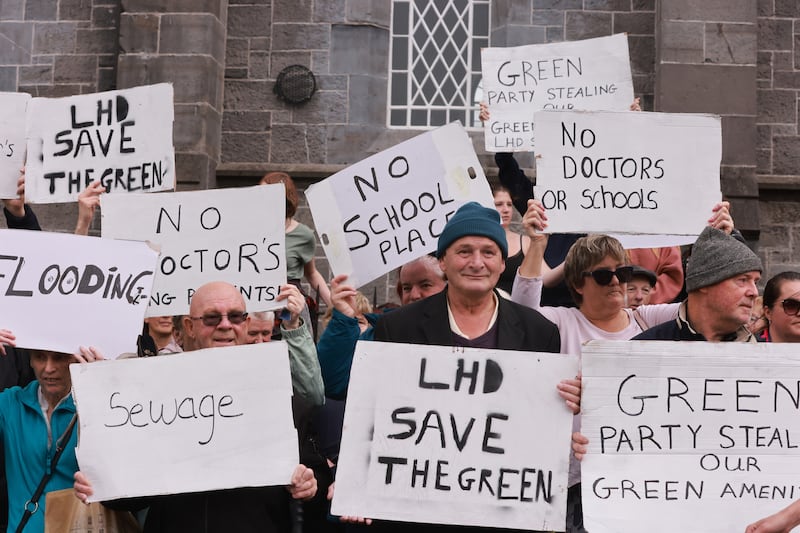There were two types of reaction in Government to the news this week that 135 Ukrainian women and children were to be bussed out of Killarney to Westport with next to no warning.
The first type of reaction was voiced by the likes of the Minister for Social Protection Heather Humphreys and Fine Gael TD Fergus O’Dowd, both of whom described it as “unacceptable”. They made these comments after a last-minute scramble which saw the refugees told they could remain where they were, except in different accommodation.
The second type of reaction came from inside the Department of Children, which is responsible for managing the short-term accommodation needs for those fleeing the war in Ukraine. Officials there did not breathe a sigh of relief. Instead, they ruminated on the fact that while it may not have happened this time, it will almost certainly happen again somewhere else in the country, and soon.
There is an understanding across Government that major changes will be needed if the country has any chance of being able to cope in the long-term with the continuing influx of refugees. Nowhere is that urgency felt more than within the Department of Children, led by Minister Roderic O’Gorman.
‘Reaching the limit’
“We are getting to the stage where we are reaching the limit of what we can feasibly do,” one senior Coalition source told The Irish Times.
They say the State is on the precipice of reaching its limit in terms of what it can do to house those fleeing the war in Ukraine, as well as other international protection applicants who continue to arrive.
Some 4,500 households offered to open their homes up as part of the pledge process, but there is a growing anxiety in Government about the long-term viability of these pledges. One source said that many of the homes opened their doors as part of a six-month pledge, and it is now month eight. Even with the best intentions in the world, the reality has dawned that this is a multi-year situation as opposed to a months-long, temporary crisis.
‘We are always looking for extra hotels. They might come to us or we might go looking for them, but realistically we are probably near the ceiling in terms of this option’
Another source confirmed that the State has also reached the ceiling of how many hotels it can contract. There are currently around 500 hotels accommodating the men, women and children from Ukraine and elsewhere. “We are always looking for extra hotels. They might come to us or we might go looking for them, but realistically we are probably near the ceiling in terms of this option,” they said. Adding to the pressure is the fact that many of the contracts with these hotels are due to end by Christmas.
The situation has also been complicated by the return to college of third-level students, with refugees being told they would have to leave the student accommodation they were placed in throughout the summer.
It would appear that few stones have been left unturned in the race to find space: the Government has mobilised to try to find available guesthouses, former religious buildings, sports halls, youth hostels, scout dens, arenas, holiday villages and tented camps.
And it is a race. On the week of October 3rd, 1,800 refugees arrived into Ireland, with 300 of them being from countries other than Ukraine. In total, since Russia’s invasion of Ukraine in February, Ireland has welcomed almost 55,000 displaced Ukrainians. The Government this summer modelled different scenarios examining the potential influx, but the level of arrivals are tracking above expectations.
“We are talking about finding a place to stay for a population that is almost the equivalent of Waterford city. We have never had to deal with anything like this before. The challenge is immense,” a Government source said. “We had Brexit, we had Covid, we had our major plans for those crises. We need another effort even beyond those two for this.”
The obvious question is: if this a long-term crisis, what are the long-term solutions?
Long-term options
This week, a group of senior officials met to get the ball rolling on that very question. They are made up of senior figures from all the relevant departments: Justice, Children, Housing, the Taoiseach. They are working on a paper of options now, which is due to be finalised next week. This paper of long-term options will then be considered by a dedicated Cabinet committee which oversees and co-ordinates the Ukrainian humanitarian response. That meeting of Ministers is provisionally scheduled for Monday, October 24th.
One of the most eye-catching suggestions to be discussed would involve asking people in direct provision to pay rent if they are working and have been in the direct provision centre for a number of years
It clear that what is under consideration is a fundamental rethink of how the State approaches the situation in the long-term. Few expect the conversation to be easy, with some major policy changes potentially on the cards.
Everything from social welfare payments to financial supports for families and work permits for refugees will be discussed. One of the most eye-catching suggestions to be discussed by the committee would involve asking people in direct provision to pay rent if they are working and have been in the direct provision centre for a number of years.
Explaining the thinking behind this, one official said that there are some people who have remained in direct provision for years and despite being in employment, it appears they do not want to leave. Whether it is that they do not want to leave, or simply can’t find anywhere to go, is another question. The official, speaking privately, said that if a person has a permanent status and is working in Ireland, the question that will be asked in the meeting will be: why should they have “rent-free accommodation” when refugees are sleeping on chairs in Citywest?

Another source confirmed that this would be part of the discussion, but it is a complicated and thorny topic. There are concerns about creating a landlord-tenant relationship within direct provision centres, and so another option could instead see fees charged for services.
Another topic up for consideration is whether Ukrainian refugees being housed under those 4,500 pledges should be asked to contribute towards the monthly bills. This will particularly be the case if the person being accommodated is working. Records from the Revenue Commissioners show that there are 9,520 refugees in paid employment with 4,080 employers.
The Government is also considering a “second call” for pledged properties with potential financial incentives on a county-by-county basis. It is not yet known whether increased payments beyond the monthly €400 will be considered, but it is understood there were provisional conversations about this throughout the summer.
Current estimates circulating between Coalition sources also estimate that there are still more than 1,000 homes of the original pledges to be assessed for suitability.
Another potentially controversial option will involve looking at the rules on social protection and other benefits and deciding whether the criteria to receive them should be the same as for everyone else. Under the current rules, there is a fast-track approach in processing applications for welfare supports for those from Ukraine, as well as a simplified decision-making process for income supports and a quick processing of PPS numbers to allow access to public services.
Limiting welfare payments
As of October 5th, a total of 56,445 PPS numbers have been allocated. Of these, 36,104 were in respect of people aged between 18 and 65. Another question due to be debated around the table of the committee is whether access to social welfare payments should be limited to nine months or some other period of time, as is this case in other European countries.
One of the side-notes to be discussed is that there is now evidence that there are more males from Ukraine arriving, with the figure rising to somewhere in mid-30 per cent range. “It is being monitored closely,” a source said. What final decision the Government arrives at is unknown.
Given the talk this week of a pause to arrivals at Citywest, could we see a situation where the Government puts a full stop to all arrivals from Ukraine? Two senior sources say the answer is no. They say there are other options that could be considered, such as expanding access to work permits in the first instance. All of these things can be considered and potentially changed, but the pressure in relation to finding accommodation remains.

While Minister O’Gorman and the Department of Children are responsible for leading the immediate humanitarian response, including organising the short-term accommodation needs of those seeking protection and refuge, it is the Department of Housing that has been partially tasked with thinking ahead.
Minister for Housing Darragh O’Brien and his officials are a key part of that dedicated Cabinet Committee.
Refurbishment project
As part of the work of the committee, an “Emergency Refurbishment Ukraine Project” has been set up which involves the review of properties identified as potentially suitable for refurbishment for use as multi-occupancy accommodation.
Each local authority was told to send a list of vacant public and private buildings that could be made fit for purpose. Mindful of the criticism that so many housing projects in Ireland get caught up in bureaucratic red tape, a “clearing-house group” with a number of experts has been set up in the Department of Housing specifically to look at contractual, operational and compliance matters in relation to planning permissions. An initial trawl at the start of the summer threw up 500 properties, with 90 of these capable of accommodating around 5,300 people.
One source said that since then, refurbishment has been ongoing across local authorities and the most up-to-date information shows that this should now yield 3,000 places.
One source said that an option under consideration as part of the long-term plan is a much broader roll-out of modular units across the country, beyond the initial 500 that are due to be ready by next February or March
There is another inventory of sites being prepared by the department, the Office of Public Works and local authorities.
This list details what sites around the country could be used for modular housing. One source said that an option under consideration as part of the long-term plan is a much broader roll-out of modular units across the country, beyond the initial 500 that are due to be ready by next February or March.
The hope is that these modular homes could initially accommodate up to 2,000 people. The sites that were initially picked were in Cavan, Cork and Tipperary. This is the first phase of the planned development, with officials whittling down a list for a second phase of modular homes that will be delivered later in 2023. Regardless of where they are, each site will have roads, footpaths, street lighting, community facilities, including a play area and green spaces. The modular homes will be energy efficient with an A2 BER and a shelf-life of 60 years.
Even these plans are not without controversy, however. Newbridge residents last month protested against the planned construction of 30 modular homes in the Kildare town. Residents complained that local authorities had ignored flooding and sewage issues.

One organiser also complained that the town is overpopulated and the amenities are “overstretched”. In the same way, officials are resigned to having to move refugees from one part of the country to the other, they are also aware that many similar protests could lie ahead, and this could complicate the grand plan to use modular homes as a long-term solution.
The other issue at play is the high cost. There is an estimated cost of at least €100 million for the first phase of the modular plan. And although no politician wants to be seen to be complaining about the cost of providing humanitarian supports in a crisis the likes of which has not been seen since the second World War, the number of arrivals keeps rising, making long-term solutions more pressing.
Gobbled up
In the coming weeks, Minister for Children Roderic O’Gorman will ask for a so-called supplementary estimate of €850 million to pay for the rising cost of housing Ukrainian refugees. Effectively, he is nearly €1bn over the budget that was agreed for 2022. The Government has decided to set aside €2 billion for 2023 for the costs related to Ireland’s response to the war in Ukraine. Some of this funding will be held in reserve and given to departments where needed, but no one doubts that it will be quickly gobbled up.
The Department of Children has modelled three scenarios in relation to the potential costs in 2023. Under the first scenario, a lower number of refugees would need support: in the region of 55,000 by the end of 2023. That is the current number of refugees who have been accommodated. This would cost €1 billion to €1.6 billion in 2023.
Under the second scenario, a medium number of 65,000 refugees would be in need of such support by the end of 2023. This would cost €1 billion to €1.8 billion. Under the final, higher-case scenario, 75,000 refugees could need support, which would cost €1 billion to €2.2 billion.
The message from senior officials tasked with trying to keep an eye on the figures is simple: yes, the pressures being experienced in Ireland are nothing compared with the suffering and trauma being inflicted upon Ukraine and its people, and in the long run, Vladimir Putin must not win. But it does not mean that the toll on the exchequer and wider society should be discounted.
The questions due to be raised this week and next will not be easy or uncontroversial. But the message from within Government is that major changes are now needed as the country moves into a different phase of its humanitarian response.












